I have been making dosa — an unleavened fermented Indian bread — for more than 30 years. It has been a staple part of my diet.
Years ago my sister-in-law, who lives in India, brought me two wet grinders that she purchased in India. Back in 2020 I wrote an article for SurvivalBlog explaining how these work and how to make dosa dough using them:
Making Dosa – Indian Fermented Bread, by E.P.
Since they have an electric motor, and because of the way they are designed, they are not usable without electricity.
I began to think about a way to make dosa without electricity should the need ever arise. Years ago my dad made an exercise bicycle out of an old single speed bicycle. He removed the front wheel and the tire
and tube from the rear wheel and made a wooden frame to mount the bicycle to. He then made a hinged wooden platform that bolted to the bicycle frame below the seat, and mounted an old car generator to the
platform above the rear wheel. There was a long v-belt around the rear wheel rim and the generator pulley. The v-belt was held tight by moving a wooden stick upright between the wooden bicycle frame and the
platform that the generator was mounted to. Resistance was provided as the bicycle was pedaled by the rotating generator connected to the rear wheel rim via the v-belt.
I was originally thinking about adapting this concept to power the wet grinders. I saw several YouTube videos showing rigs people have made to power a flour grinder with a bicycle, but these grinders have a pulley that is mounted vertically, not horizontally as my wet grinders are configured. The motor on my wet grinders is mounted vertically to the side of the stainless steel pan with the flat granite bottom. The output shaft of the motor faces downward, to which a small pulley is attached. There is a much larger pulley attached below a bearing assembly that the stainless steel pan sets on. A v-belt connects the small pulley on the bottom of the motor to the large pulley below the stainless steel pan. To power a wet grinder with a bicycle would require a 90-degree gearbox to convert the motion of the vertically aligned bicycle chain or pulley to the horizontally aligned pulley below the stainless steel pan of the wet grinder. A reasonably priced gearbox suitable for this purpose would be very hard to find.
Faced with these challenges, I wondered how people made dosa dough in primitive times without the aid of electricity or mechanical aids like bicycles. My wife told me that her mother, who was born and raised in
what is now Lahore, Pakistan (although back then it was still part of India), had a large flat granite stone and a heavy granite roller that she used to grind grain. My mother-in-law passed away many years ago, and my wife doesn’t know what happened to her mother’s granite grinder, so I had to start looking around. I found something on amazon.com called an ammikal.
An ammikal is a rather large flat rectangular slab of granite measuring 10 inches wide by 15 inches long, along with a granite roller that is shaped similar to a wooden rolling pin used to make bread and pastries. (See photo at left.) The ammikal, including both pieces, is rather heavy, weighing 33 pounds (although my wife said that both the granite stone and roller that her mother had were considerably larger and heavier). I ordered one, but didn’t realize that they are made in Tamil Nadu, India, and are shipped directly from there to the US. So it took a while to get it.
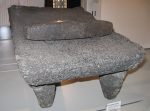 Before purchasing the ammikal, I looked at some other designs. There is a similar device made in Mexico used to grind dry corn to make flour for tortillas, called a metate. The ones made today are essentially the same design as the ancient ones that you see on display in museums. (See photo.) But the modern ones have a raised ridge around the edges to help prevent the flour from falling over the edges of the stone, which is a great idea. Unfortunately, metates are made out of porous volcanic rock, so they wouldn’t work to grind soaked grains because the liquid would be absorbed by the volcanic rock.
Before purchasing the ammikal, I looked at some other designs. There is a similar device made in Mexico used to grind dry corn to make flour for tortillas, called a metate. The ones made today are essentially the same design as the ancient ones that you see on display in museums. (See photo.) But the modern ones have a raised ridge around the edges to help prevent the flour from falling over the edges of the stone, which is a great idea. Unfortunately, metates are made out of porous volcanic rock, so they wouldn’t work to grind soaked grains because the liquid would be absorbed by the volcanic rock.
The top of the ammikal is completely flat, except that a small front section is dished slightly, creating a place for the roller to set into so it doesn’t fall off the front edge.
The instructions that came with the ammikal say to first wash it with water to clean off the dust created during manufacturing.
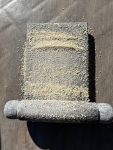 Next, the ammikal must be “broken in” by putting dry uncooked rice on the top flat surface and grinding it until it becomes powder. The instructions say to do this 3 or 4 times, but I only did it once because it took a long time to grind the amount of rice I used (about 1/8 cup). I had trouble keeping the rice from falling off the edges
Next, the ammikal must be “broken in” by putting dry uncooked rice on the top flat surface and grinding it until it becomes powder. The instructions say to do this 3 or 4 times, but I only did it once because it took a long time to grind the amount of rice I used (about 1/8 cup). I had trouble keeping the rice from falling off the edges
of the ammikal, and had to periodically scoop up the rice that fell off and put it back on the top surface.
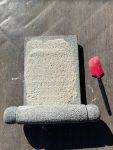 It took a while to figure out the best method to grind the rice. First I used a rolling motion (like you would use a wooden rolling pin) and not much happened to the rice grains. Then I used a pushing motion, holding the roller stationary, and all that did was to push the rice off the ammikal on the back side. What worked for me was to use a combination of rolling slowly and pushing the roller. The top of the ammikal and the surface of the roller are quite rough, not smooth at all, so both surfaces tend to grab the rice grains and hold them, allowing them to be crushed into a fine powder. I also had to tilt the roller a bit to the left and then to the right as I ground the grain to make sure the grains toward the edges of the top surface were crushed. If I were using the ammikal to grind dry grain, I would want to periodically sift the flour into a container, leaving the more coarse grains to be reground finer until all the flour was a consistent size.
It took a while to figure out the best method to grind the rice. First I used a rolling motion (like you would use a wooden rolling pin) and not much happened to the rice grains. Then I used a pushing motion, holding the roller stationary, and all that did was to push the rice off the ammikal on the back side. What worked for me was to use a combination of rolling slowly and pushing the roller. The top of the ammikal and the surface of the roller are quite rough, not smooth at all, so both surfaces tend to grab the rice grains and hold them, allowing them to be crushed into a fine powder. I also had to tilt the roller a bit to the left and then to the right as I ground the grain to make sure the grains toward the edges of the top surface were crushed. If I were using the ammikal to grind dry grain, I would want to periodically sift the flour into a container, leaving the more coarse grains to be reground finer until all the flour was a consistent size.
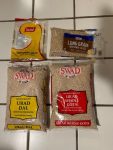 To make dosa dough the grains must first be soaked in water for about 8 hours. The ingredients I used were brown rice, urad dal, and fenugreek (methi) seeds. Either urad dal (split beans) or urad gota (whole beans) can be used. I normally use urad gota when using a wet grinder because I think the whole beans store longer than the split beans. However, when using the ammikal it is easier to crush the split beans than the whole beans, so I used urad dal.
To make dosa dough the grains must first be soaked in water for about 8 hours. The ingredients I used were brown rice, urad dal, and fenugreek (methi) seeds. Either urad dal (split beans) or urad gota (whole beans) can be used. I normally use urad gota when using a wet grinder because I think the whole beans store longer than the split beans. However, when using the ammikal it is easier to crush the split beans than the whole beans, so I used urad dal.
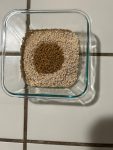 The traditional recipe is 3 parts rice, 2 parts urad dal, and a comparatively small amount of fenugreek seeds. For this small batch I used 1/4 cup of brown rice, 2/3 that amount of urad dal, and about a tablespoon of fenugreek seeds. When using a wet grinder I usually soak 2 cups of rice, 2/3 that amount of urad gota, a half cup of fenugreek seeds, and a half cup of either millet, rye, or barley. It takes me so long to clean the wet grinder when I am finished, that I make enough dough to use short term and enough to
The traditional recipe is 3 parts rice, 2 parts urad dal, and a comparatively small amount of fenugreek seeds. For this small batch I used 1/4 cup of brown rice, 2/3 that amount of urad dal, and about a tablespoon of fenugreek seeds. When using a wet grinder I usually soak 2 cups of rice, 2/3 that amount of urad gota, a half cup of fenugreek seeds, and a half cup of either millet, rye, or barley. It takes me so long to clean the wet grinder when I am finished, that I make enough dough to use short term and enough to
freeze for later use. Making that much dough at once with an ammikal would take a very long time and would be a real workout.
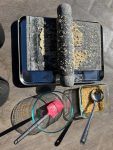 Before starting to grind the soaked grains I put a stainless steel baking sheet, 17.6 inches x 13 inches x 1 inch under the ammikal to catch the grains that fell over the sides of the ammikal. (See photo). Grinding the soaked grains is a bit different than grinding dry grain. With soaked grains more of a rolling motion than a sliding motion is necessary, because the soaked grains are more slippery than the dry grains are, and they tend more to be pushed than to roll under the roller. This requires more of a downward force on the roller, which is more tiring to the arms.
Before starting to grind the soaked grains I put a stainless steel baking sheet, 17.6 inches x 13 inches x 1 inch under the ammikal to catch the grains that fell over the sides of the ammikal. (See photo). Grinding the soaked grains is a bit different than grinding dry grain. With soaked grains more of a rolling motion than a sliding motion is necessary, because the soaked grains are more slippery than the dry grains are, and they tend more to be pushed than to roll under the roller. This requires more of a downward force on the roller, which is more tiring to the arms.
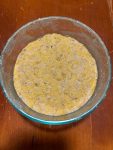
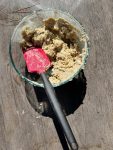 I ground the grains that I had soaked in four batches, and it took me about a half hour to grind all four batches (see photo at left). The dough is drier and coarser than when using a wet grinder, so a bit of water must be added to make the dough the right consistency. (See photo at right.)
I ground the grains that I had soaked in four batches, and it took me about a half hour to grind all four batches (see photo at left). The dough is drier and coarser than when using a wet grinder, so a bit of water must be added to make the dough the right consistency. (See photo at right.)
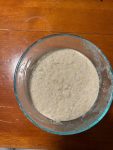 At this point the dough should be covered and stored at room temperature for 24 to 48 hours (depending on room temperature) so that it will rise.
At this point the dough should be covered and stored at room temperature for 24 to 48 hours (depending on room temperature) so that it will rise.
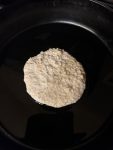
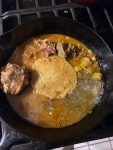 After fermentation is complete it is ready to cook. I put a tablespoon or two of coconut oil in a skillet, warmed it up, and added some dosa dough (see photo at left). When it is ready to flip over, the top will not appear to be wet. Flip it over and add previously cooked meat and vegetables as desired (see photo at right). Store the unused dough in the refrigerator, where it will keep for a long time.
After fermentation is complete it is ready to cook. I put a tablespoon or two of coconut oil in a skillet, warmed it up, and added some dosa dough (see photo at left). When it is ready to flip over, the top will not appear to be wet. Flip it over and add previously cooked meat and vegetables as desired (see photo at right). Store the unused dough in the refrigerator, where it will keep for a long time.
The consistency of the dough made with the ammikal is very different (much coarser with larger pieces of grain hulls) than dough made with a wet grinder. I grind each batch of dough in a wet grinder for about a half hour, which makes a dough with very small pieces of grain. Although both the ammikal and the wet grinder grind the grain by mashing it, the action of the wet grinder is different than the ammikal. The stones of the wet grinder are smooth, and skid on the smooth bottom granite base of the stainless steel pan of the wet grinder.
The roller and base of the ammikal are coarse and rough, and work by both tearing and mashing the grains.
I much prefer using my wet grinders to make dosa dough, but now I have peace of mind knowing that I can still make dosa even if I have no electricity to power my wet grinders. Although I have not tried to make coarse unleavened wheat bread (called Essene bread) from soaked wheat grains, I have no doubt that it could be done using an ammikal. My mother-in-law probably used hers mostly to make chappati, which
is an unleavened Indian wheat bread.
I hope that you find this article useful, even if you are preparing other wheat, corn, or rice-based foods.
Read the full article here

